Looking for a fermented bread and butter pickle? These honey garlic pickles are sweet, sour, and deliciously spiced. Perfect for sandwiches, barbecues, or snacking.
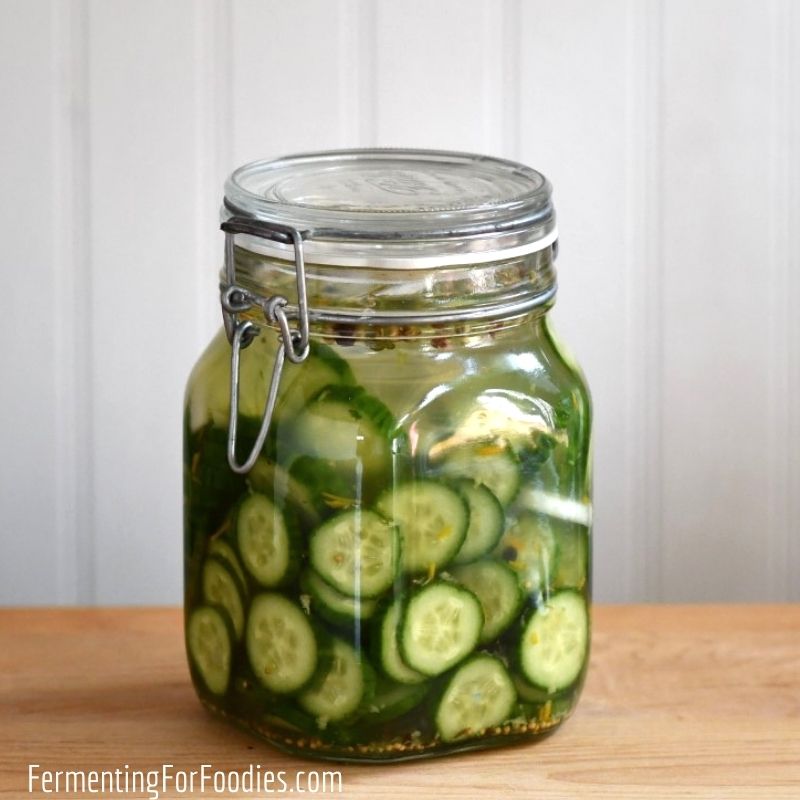
There are some vegetables that are just MADE for fermentation, and cucumbers are one of those vegetables. They naturally ferment, which is why traditional pickles always involve fermentation (even if you can them afterwards).
However, sliced honey garlic pickles don’t follow this traditional method. Instead, they use raw honey to provide the culture for a quick, sweet ferment. Finished within 3-5 days, these are more like a fermented refrigerator pickle.
They are a simple and delicious alternative for anyone who prefers a sweet pickle.
Fermenting with Honey
Raw honey is full of yeasts and bacteria that come from the bees’ microbiome. However, in its raw state, honey is actually antimicrobial. That’s because the sugars are so thick, that nothing can grow in it. As soon as those sugars are diluted the honey will naturally start to ferment! This is the basis of mead and other honey ferments.
I love fermenting with honey. It is so reliable. Perfect for beginners or anyone who struggles with wild fermentation. And if you’ve never fermented with honey, then you’re in for a surprise. All the sugars are quickly fermented for a resulting pickle that is not nearly as sweet as you would expect.
The key to fermenting with honey is to use unadulterated honey. Here’s how you can tell if your honey will work for you:
- Look for raw or unpasteurized on the label.
- Try a small, local producer. It might be more expensive, but that’s because it’s the real thing.
- You can also find raw honey online.
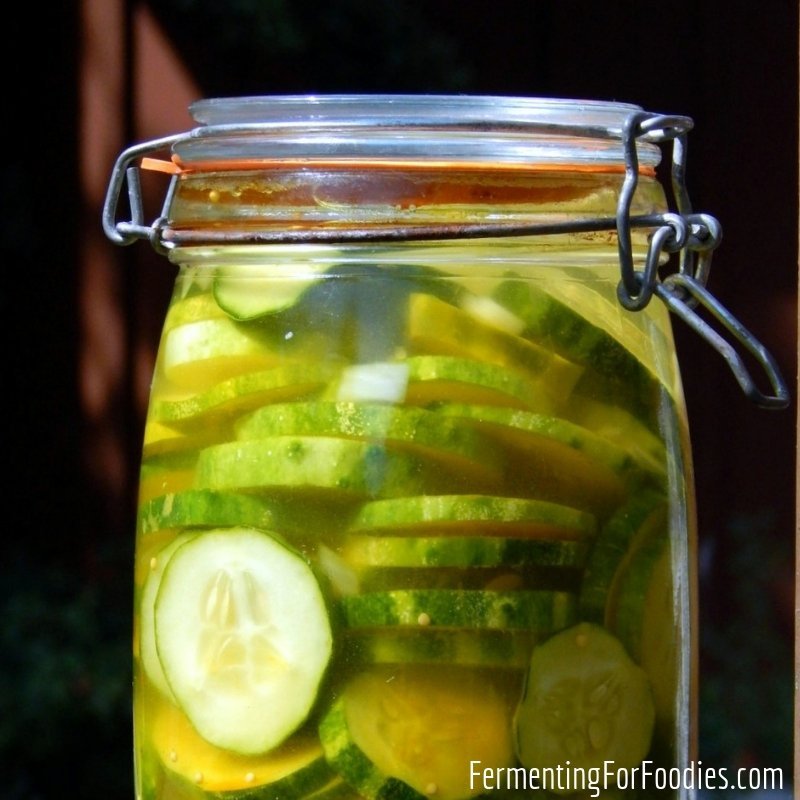
Honey Garlic Pickles
These probiotic bread and butter pickles use raw honey to provide the culture for a quick ferment. The result is a deliciously sweet and flavorful pickle that is ideal for picnics and barbecues.
- Prep Time: 15 minutes
- Total Time: 15 minutes
- Yield: 1 quart 1x
- Category: Pickles
- Method: Fermented
- Cuisine: Probiotic
- Diet: Gluten Free
Ingredients
- 1 lb pickling cucumbers (about 6 to 8)
- 1 clove of garlic
- 1 tsp pickling spice
- 1/2 tsp ground ginger
- 1/4 tsp ground turmeric
- 1 tsp of non-iodized salt
- 2 Tbsp unpasteurized honey
- 1 1/2 cups of water (chlorine-free, enough to cover)
- 1/2 cup of cider vinegar (optional)
Instructions
- Wash the cucumbers and trim off the blossom ends. Cut them into circles or sticks, depending on your preference. Pack the cucumber slices into a clean 1-quart jar. Add garlic and spices to the jar.
- Combine the water, honey, and salt to make a brine. Pour the brine over the cucumbers. Use a weight to keep the cucumbers submerged. If needed, top with a little more water to make sure the cucumbers are under the brine.
- Allow to ferment somewhere cool and dark for 2 -5 days. A closet or kitchen cupboard is perfect. The ferment will bubble vigorously, so be sure to use a lid that will release the excess carbon dioxide.
- After fermenting, taste a pickle slice and adjust the flavors to suit your taste. To make them more sour, drain away 1/2 cup of brine and replace it with 1/2 cup of cider vinegar. To make them sweeter, stir in 2 Tbsp of white sugar.
- Store in the refrigerator and enjoy within 1 month.
Notes
- The brine can be reused to make subsequent batches of pickles. After finishing the pickles, stir in another 1 Tbsp of honey, then fill the jar with cucumber slices and ferment again. Usually, I make 2-4 batches of pickles with my brine.
- I do not recommend this recipe for storage pickles. It is meant to be eaten fresh.
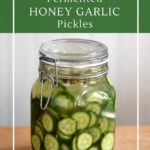
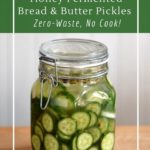
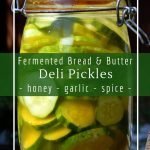
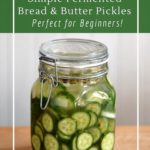
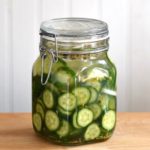
These turned out great! And I was amazed how quick and easy they were to make. I’ll definitely be making these again.
Could you do this with red onions? I’m wanting to get a sweet & sour sliced onion for salads etc…
I haven’t honey fermented onions before… I’m not certain if it would work. I think part of it is that garlic has it’s own particular bacterial properties. Maybe try making my honey fermented pickles with onions instead of cucumbers: https://www.fermentingforfoodies.com/honey-garlic-pickles/
Yes you can use onions.
I have a question about this recipe. Would it hurt anything to add a couple of tablespoons of cider vinegar initially.
Adding 2-3 Tbsp of vinegar won’t hurt the ferment. However, it will act more as a flavor, since the honey provides all the necessary yeast and bacteria. Raw honey tends to be quite vigorous, and I imagine it will outcompete the bacteria in raw ACV. Cheers!
i’m wondering if the brine needs to be boiled before adding to the cucumbers in the jar
thanks
No need to pre-boil the brine (unless your water requires boiling to be safe to drink). This is a fermented cucumber recipe. So the brine needs to be room temperature before you add the honey and cucumbers. Good luck!
thanks so much!
Can you use brown sugar instead?
Yes! Brown sugar is definitely better than refined white sugar (which may contain preservatives to keep it looking white.) Enjoy!
Hi Emily, does this recipe bubble like other fermenting recipes? 3 days in and not seeing bubbles or cloudy water. Thank you
Honey ferments differently from brine. You won’t see cloudiness or bubbles. However, it should be sparkling. So if you’re concerned, just dip in a spoon and taste a bit of the brine. It should be slightly sparkling. Good luck!
I’ve never pickled or fermented anything before and your recipe seems so easy I figured I’d give it a shot! They seem to be fermenting nicely but they’re a bit bitter to the taste. Any ideas? (I did have to change some of the spices since my boyfriend has some allergies, I put in the garlic, black peppercorn, clove, bay leaf.)
Hi Diana, I’m glad your first ferment is bubbling nicely! I’m not exactly sure what is causing the bitterness. Sometimes cucumbers can be bitter, especially if they’re old/overgrown. Depending on how much spice you added, they could be bitter. But as long as you didn’t use more than 2 tsp total (for all spices) then it’s probably fine. Try adding the cider vinegar to see if that helps to cut the bitterness. Good luck!
I began the fermentation process 2 days ago. Raw honey was used. Today it is very cloudy and bubbling out of the jar. You stated honey doesn’t get cloudy during fermentation. Should I throw it out and try again? Any suggestions?
The bubbles are a good sign! Typical brine dill pickles get cloudy after a few weeks (from built-up yeast or bacteria). I’m not sure what is causing cloudiness in your batch. Maybe it’s just an extra excited ferment with lots of yeast and Lacto-bacteria? Cloudy pickles aren’t usually bad. Look for smelliness (rotten/bad) or mold on top. I wouldn’t throw it out without giving it a sniff first. If the cloudiness is due to really excited fermentation (which it sounds like you have) it will clear as the ferment slows down. Enjoy!
Hi Emilie,
I’m curious how you keep small seeds from rising to the top of the brine. They always find a way to sneak past my fermentation weight….Also, if they sit at the top, could they cause the brine to spoil or mold? Thanks
Hi Gayle, I usually put the seeds in the bottom, then really pack the jar with pickle slices. However, some will escape. These can cause mold issues. With a salt-brine ferment, you don’t have to worry about mold going into the brine. It just can’t contaminate anything that is kept under the brine. With this ferment, mold can contaminate the liquid. If you have it packed into a regular mason jar, then only ferment for 3 to 5 days.
Cheers, Emillie